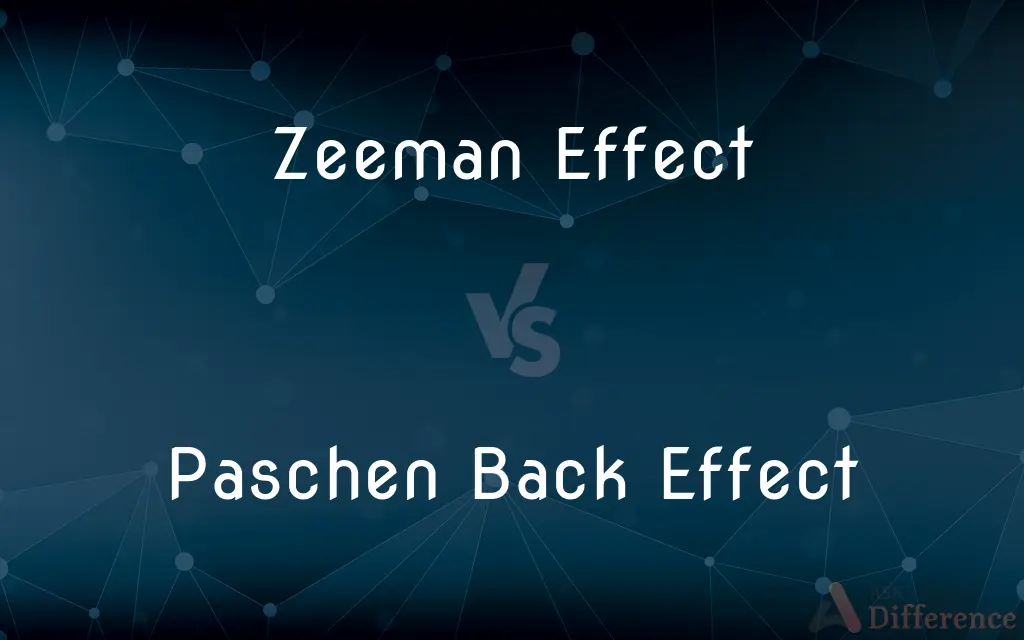Zeeman Effect vs. Paschen Back Effect — What's the Difference?
By Tayyaba Rehman — Published on November 13, 2023
Zeeman Effect describes the splitting of a spectral line into several components in the presence of a magnetic field. The Paschen Back Effect refers to the further splitting and polarization of these spectral lines at stronger magnetic fields.

Difference Between Zeeman Effect and Paschen Back Effect
Table of Contents
ADVERTISEMENT
Key Differences
The Zeeman Effect is a phenomenon that was first observed in 1896, where the application of an external magnetic field caused the splitting of spectral lines in light emitted or absorbed by atoms. This discovery showcased the relationship between electromagnetic radiation and the magnetic field surrounding atomic particles. In contrast, the Paschen Back Effect is a special and more extreme case of the Zeeman Effect. When the magnetic field applied is particularly strong, the coupling between the electron's orbital and spin angular momentum can be disrupted, leading to the splitting of atomic energy levels.
The Zeeman Effect typically reveals itself as three lines (triplet) for transitions where the total angular momentum quantum number changes by one unit. It provided initial evidence for the quantization of angular momentum. The Paschen Back Effect, however, takes over at stronger magnetic fields, displaying a different splitting pattern due to the fact that the electron's spin and orbital motions are essentially decoupled.
It's essential to note that while both the Zeeman Effect and the Paschen Back Effect revolve around the impact of magnetic fields on atomic spectral lines, they manifest under different field strengths and result from different atomic interactions. The Paschen Back Effect is specifically significant for atoms with larger angular momentum quantum numbers, as the strong field alters the usual energy state relationships.
The practical applications and studies concerning the Zeeman Effect have been instrumental in areas like atomic physics and quantum mechanics. Meanwhile, the Paschen Back Effect offers deeper insights into atomic structure, especially under extreme conditions, and helps refine our understanding of atomic behavior.
The Zeeman Effect pertains to the phenomenon where spectral lines split into multiple components when subjected to a magnetic field. Contrarily, the Paschen Back Effect emerges when the magnetic field is so strong that it uncouples the electron’s spin and orbital angular momentum, leading to further splitting and polarization of the spectral lines.
ADVERTISEMENT
Engaging with the Zeeman Effect, one observes a magnetic field causing the energy levels of an atom's electrons to separate. Meanwhile, in scenarios involving the Paschen Back Effect, a robust magnetic field causes the separation and polarization of spectral lines by overpowering the spin-orbit coupling, thus altering the energy levels dramatically.
The Zeeman Effect is widely applicable and observable in scenarios with relatively weaker magnetic fields and encompasses both transverse and longitudinal effects on spectral lines. On the other hand, the Paschen Back Effect typically presents itself under significantly stronger magnetic field conditions, pushing the spectral line splitting into a regime where the normal Zeeman Effect no longer applies.
Within the context of the Zeeman Effect, the electron's total angular momentum is slightly altered due to the influence of a magnetic field. In stark contrast, the Paschen Back Effect renders the electron’s orbital and spin angular momenta to behave independently, each aligning according to the magnetic field, thereby creating additional spectral lines and components.
In a nutshell, the Zeeman Effect signifies the initial stages of spectral line splitting induced by a magnetic field, showcasing a foundational quantum mechanical phenomenon. In contrast, the Paschen Back Effect reveals the complex, intensive splitting and polarization of spectral lines occurring under significantly powerful magnetic field intensities, indicating a transition into a different quantum mechanical regime.
Comparison Chart
Definition
Splitting of spectral lines due to magnetic fields
Splitting of atomic energy levels in strong magnetic fields
Field Strength
Observed in weaker fields
Manifests in particularly strong fields
Angular Momentum Impact
Provides evidence for quantization of angular momentum
Spin and orbital motions are decoupled
Number of Split Lines
Typically results in a triplet
Splitting pattern varies
Relevance
Foundational for atomic physics and quantum mechanics
Gives insight into atomic structure under extreme conditions
Magnetic Field Strength
Operative in weaker magnetic fields.
Comes into play in very strong magnetic fields.
Spectral Line Components
Spectral lines split into multiple components.
Spectral lines undergo further splitting and polarization.
Angular Momentum Interaction
Total angular momentum is slightly altered.
Spin and orbital angular momentum interact independently.
Application in Astrophysics
Observed in various astrophysical phenomena.
Typically observed in stars with extremely strong magnetic fields.
Analytical Complexity
Analytical approaches are less complex.
Analytical approaches involve more complexity due to intense field strengths.
Compare with Definitions
Zeeman Effect
Phenomenon showcasing the interplay between electromagnetic radiation and magnetic fields.
The Zeeman Effect was one of the early evidences supporting quantum theory.
Paschen Back Effect
An extreme case of the Zeeman Effect in strong magnetic fields.
The Paschen Back Effect showcases the behavior of atoms under intense magnetic conditions.
Zeeman Effect
A tool to study atomic and molecular details.
Using the Zeeman Effect, researchers can probe the inner workings of atoms and molecules.
Paschen Back Effect
A phenomenon observed when spin and orbital angular momenta are affected differently.
The Paschen Back Effect reveals the intricate atomic interactions in very strong magnetic fields.
Zeeman Effect
Result of the external magnetic field's impact on atomic electron energies.
The distinct patterns observed during the Zeeman Effect are a direct consequence of quantum mechanics.
Paschen Back Effect
Splitting of atomic energy levels due to decoupling of electron motions.
As magnetic strength increases, the Paschen Back Effect takes prominence over the Zeeman Effect.
Zeeman Effect
Manifestation of the quantization of angular momentum in atomic systems.
Through the Zeeman Effect, scientists gained insights into how atomic particles respond to magnetic fields.
Paschen Back Effect
It occurs when the magnetic field overpowers electron spin-orbit coupling.
The spectral line components showed characteristics of the Paschen Back Effect due to a dominating magnetic field.
Zeeman Effect
The Zeeman Effect involves the splitting of spectral lines under a magnetic field.
Observing the sunspot spectra reveals the Zeeman Effect, visible as spectral line splits.
Paschen Back Effect
The Paschen Back Effect involves spectral line splitting in a strong magnetic field.
When observing stellar magnetic fields, astronomers noted the Paschen Back Effect in spectral lines.
Zeeman Effect
It denotes a phenomenon observable in both weak and moderate magnetic field strengths.
The Zeeman Effect was evident when the spectral lines divided upon magnetic field application.
Paschen Back Effect
Result of the disruption of the usual coupling between electron motions.
The altered splitting patterns in the Paschen Back Effect are due to decoupled electron behaviors.
Zeeman Effect
This effect can be categorized into Normal and Anomalous Zeeman Effects.
Different electron transitions lead to the various patterns seen in the Anomalous Zeeman Effect.
Paschen Back Effect
Insight into atomic structures under extreme conditions.
The Paschen Back Effect is crucial for understanding atoms in environments like neutron stars.
Zeeman Effect
Splitting of atomic spectral lines in a magnetic field.
Observing the Zeeman Effect helps in understanding atomic behavior in magnetic environments.
Paschen Back Effect
This effect demonstrates a breakdown of the electron’s total angular momentum in intense magnetic fields.
The Paschen Back Effect was evident when spectral lines further separated and polarized under strong magnetism.
Zeeman Effect
The Zeeman Effect provides insight into atomic energy level alterations due to magnetism.
Scientists study the Zeeman Effect to understand changes in atomic energy levels.
Paschen Back Effect
The Paschen Back Effect is critical in analyzing energetic phenomena in astrophysics.
Stellar magnetic phenomena are often studied considering the implications of the Paschen Back Effect.
Zeeman Effect
The Zeeman Effect can influence both electron and nuclear spins.
In NMR spectroscopy, the Zeeman Effect impacts nuclear spins in a magnetic field.
Paschen Back Effect
This effect reveals complexities in quantum mechanics under robust magnetic conditions.
Through the Paschen Back Effect, researchers probe into quantum behaviors under powerful magnetic scenarios.
Common Curiosities
How is the "Paschen-Back Effect" defined?
The Paschen-Back Effect describes the splitting and shifting of atomic energy levels and spectral lines in strong magnetic fields.
What causes the Zeeman Effect in atomic spectra?
The Zeeman Effect is caused by the interaction between the magnetic field and the magnetic moment of an electron.
Can the Zeeman Effect be observed in all types of atoms?
The Zeeman Effect can be observed in atoms and ions that have unpaired electrons and hence a net magnetic moment.
How are the spectral lines split in the Anomalous Zeeman Effect?
In the Anomalous Zeeman Effect, spectral lines split into multiple components with uneven spacing due to electron spin.
What is the fundamental concept of the "Zeeman Effect"?
The Zeeman Effect refers to the splitting of a spectral line into several components in the presence of a magnetic field.
Is the Zeeman Effect applicable to nuclear physics?
Yes, the Zeeman Effect can be observed in nuclear magnetic moments, although it’s often on a much smaller scale than for electrons.
In what kind of magnetic field does the Paschen-Back Effect occur?
The Paschen-Back Effect typically occurs in strong magnetic fields, where the interaction exceeds spin-orbit coupling energy.
What is the Normal Zeeman Effect?
The Normal Zeeman Effect refers to spectral line splitting without considering electron spin, typically seen in singlet states.
Does the Zeeman Effect have implications for astrophysics?
Yes, the Zeeman Effect is used in astrophysics to measure magnetic fields of stars and other astronomical objects.
What transitions are involved in the Paschen-Back Effect?
The Paschen-Back Effect deals with transitions where the magnetic interaction dominates over the spin-orbit interaction.
Is the Paschen-Back Effect related to the Stark Effect?
Yes, while the Paschen-Back Effect deals with magnetic fields, the Stark Effect is its electrical analogue, dealing with electric fields.
How is the Zeeman Effect utilized in astronomy?
Astronomers use the Zeeman Effect to measure magnetic fields in stars and other astronomical objects.
Does the Paschen-Back Effect have practical applications?
Yes, the Paschen-Back Effect is utilized in research and technology, such as in nuclear magnetic resonance and quantum computing.
How does the Zeeman Effect relate to electron transitions?
The splitting of spectral lines in the Zeeman Effect results from electron transitions between split energy levels.
Is it possible to observe both effects simultaneously?
It's complex due to their occurrence in different magnetic field strengths, yet adjacent regions in stars might display both.
Can the Paschen-Back Effect be observed in weak magnetic fields?
The Paschen-Back Effect is generally not observed in weak fields; it becomes significant when the magnetic field strongly interacts with atomic electrons.
Paschen Back Effect
When does the Paschen Back Effect dominate over the Zeeman Effect?
What is the fundamental cause behind both the Zeeman and Paschen Back Effects?
Both are induced by magnetic fields affecting electron energy levels, but they manifest differently due to field strength.
What triggers the Zeeman Effect?
The Zeeman Effect occurs when a spectral line splits due to the presence of a magnetic field.
Does the Zeeman Effect always produce three spectral lines?
Not always. The Normal Zeeman Effect produces three lines, but the Anomalous Zeeman Effect can produce more.
It is observed through further splitting and polarization of spectral lines, especially in high magnetic field regions.
Are the Zeeman Effect and the Paschen Back Effect mutually exclusive?
What happens to energy levels during the Paschen-Back Effect?
During the Paschen-Back Effect, energy levels that were degenerate split and shift in response to a strong magnetic field.
Are the Zeeman Effect and Paschen-Back Effect exclusive to certain elements?
No, these effects can be observed in various atoms and ions with suitable electronic configurations and energy level structures.
Is the Zeeman Effect applicable to all atoms?
Generally yes, the Zeeman Effect can be observed in atoms or ions with unpaired electron spins.
The Paschen Back Effect dominates in extremely strong magnetic fields, typically overpowering the Zeeman Effect.
Does the Paschen Back Effect influence electron behavior?
Yes, it alters electron behavior by decoupling its orbital and spin angular momentum due to the strong magnetic field.
How is the Paschen Back Effect observed?
Why are these effects crucial in astrophysics?
They help astronomers decipher information regarding the magnetic fields in various astronomical objects and phenomena.
Can these effects be studied in a laboratory setting?
Yes, both effects can be studied in labs using controlled environments and magnetic fields to observe spectral line splitting.
No, the Paschen Back Effect is considered an extreme form or regime of the Zeeman Effect in strong magnetic fields.
Can the Paschen Back Effect reveal information about stellar magnetic fields?
Yes, it provides valuable insights into the magnetic fields of celestial objects like certain stars.
Both Zeeman Effect and Paschen Back Effect
Are the Zeeman Effect and the Paschen Back Effect connected?
Yes, both effects relate to the magnetic field-induced splitting of spectral lines but under different field strengths.
Share Your Discovery

Previous Comparison
Capability vs. Potential
Next Comparison
Quality Manual vs. Quality PlanAuthor Spotlight
Written by
Tayyaba RehmanTayyaba Rehman is a distinguished writer, currently serving as a primary contributor to askdifference.com. As a researcher in semantics and etymology, Tayyaba's passion for the complexity of languages and their distinctions has found a perfect home on the platform. Tayyaba delves into the intricacies of language, distinguishing between commonly confused words and phrases, thereby providing clarity for readers worldwide.
















































